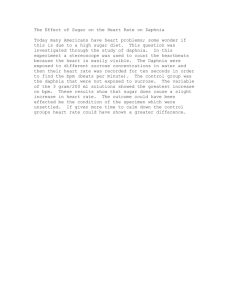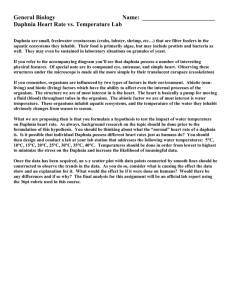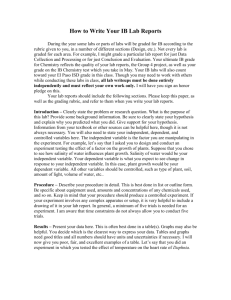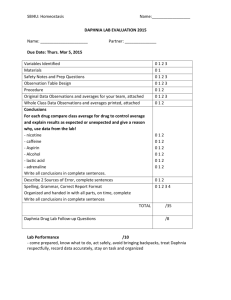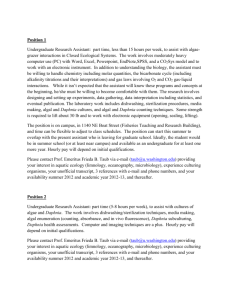Endotherms and Exotherms
advertisement
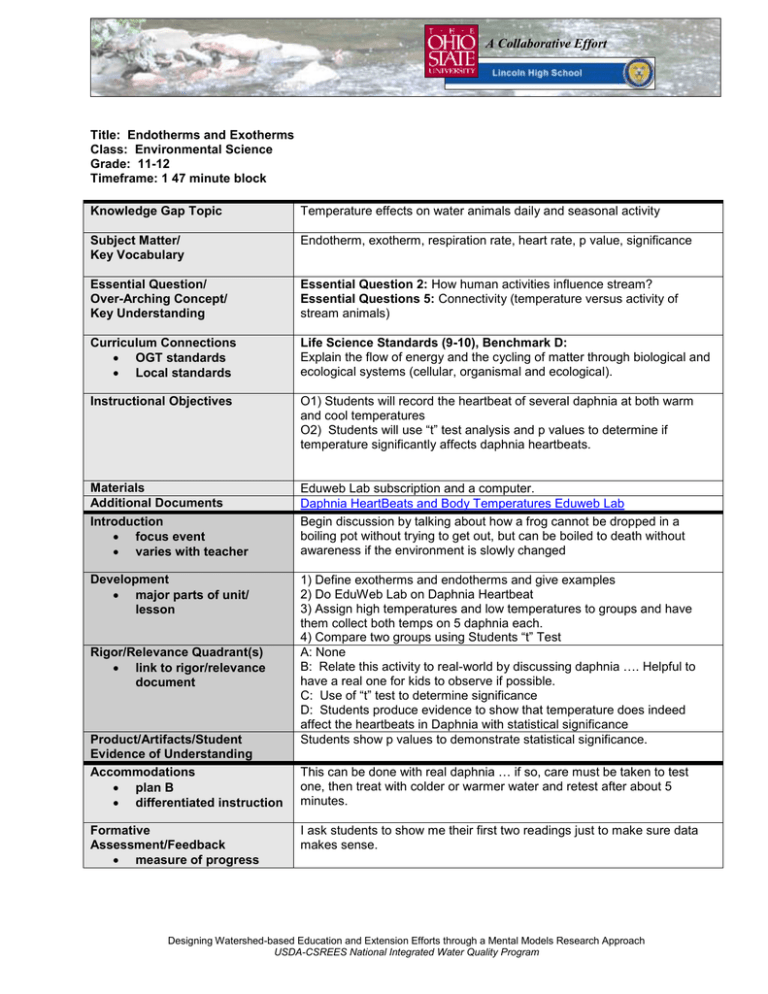
A Collaborative Effort Title: Endotherms and Exotherms Class: Environmental Science Grade: 11-12 Timeframe: 1 47 minute block Knowledge Gap Topic Temperature effects on water animals daily and seasonal activity Subject Matter/ Key Vocabulary Endotherm, exotherm, respiration rate, heart rate, p value, significance Essential Question/ Over-Arching Concept/ Key Understanding Essential Question 2: How human activities influence stream? Essential Questions 5: Connectivity (temperature versus activity of stream animals) Curriculum Connections OGT standards Local standards Life Science Standards (9-10), Benchmark D: Explain the flow of energy and the cycling of matter through biological and ecological systems (cellular, organismal and ecological). Instructional Objectives O1) Students will record the heartbeat of several daphnia at both warm and cool temperatures O2) Students will use “t” test analysis and p values to determine if temperature significantly affects daphnia heartbeats. Materials Additional Documents Introduction focus event varies with teacher Eduweb Lab subscription and a computer. Daphnia HeartBeats and Body Temperatures Eduweb Lab Begin discussion by talking about how a frog cannot be dropped in a boiling pot without trying to get out, but can be boiled to death without awareness if the environment is slowly changed Development major parts of unit/ lesson 1) Define exotherms and endotherms and give examples 2) Do EduWeb Lab on Daphnia Heartbeat 3) Assign high temperatures and low temperatures to groups and have them collect both temps on 5 daphnia each. 4) Compare two groups using Students “t” Test A: None B: Relate this activity to real-world by discussing daphnia …. Helpful to have a real one for kids to observe if possible. C: Use of “t” test to determine significance D: Students produce evidence to show that temperature does indeed affect the heartbeats in Daphnia with statistical significance Students show p values to demonstrate statistical significance. Rigor/Relevance Quadrant(s) link to rigor/relevance document Product/Artifacts/Student Evidence of Understanding Accommodations plan B differentiated instruction Formative Assessment/Feedback measure of progress This can be done with real daphnia … if so, care must be taken to test one, then treat with colder or warmer water and retest after about 5 minutes. I ask students to show me their first two readings just to make sure data makes sense. Designing Watershed-based Education and Extension Efforts through a Mental Models Research Approach USDA-CSREES National Integrated Water Quality Program Final Evaluation project rubric oral or paper quiz/test portfolio Teacher Reflection complete after lesson Students show work on collected data and then their calculations for p values from the “t” test. This is turned in as a lab. They must present evidence to show that changing temperature of water does indeed significantly change the heartbeat of the daphnia Lab is a winner. Data comes out well, “t” tests typically show excellent significance. So students not only see there is a difference in heartbeats, but they can provide statistical evidence to prove that the temperature is significantly affecting things! Designers/Email: Fred Donelson (fdonelson@gjps.org) Additional Comments: An easy way to demonstrate how environmental temperature affects exothermic body processes, as well as an easy way to introduce or reinforce significance testing in your course. Designing Watershed-based Education and Extension Efforts through a Mental Models Research Approach USDA-CSREES National Integrated Water Quality Program Daphnia HeartBeats and Body Temperatures Eduweb Lab Names: Part I: Collect Daphnia Heart Rates for one minute at the following temperatures: 5, 10, 15, and 20 degrees C. Then draw a best fit line that describes the data. Be sure to include an R2 value to show goodness of fit. Be sure to try different types of regressions to find the closest fit! Part II: Using the forecasting/trendline function, predict what the daphnia’s heartbeat would be at the following temperatures (these can be estimates based on the graph): 1 _____ 25 _____ 30 _____ Part III: Define the following terms: Endotherm Exotherm Poikilotherm Part IV: Print out your table and graph and attach it to this form. Don’t forget labels and titles!! Designing Watershed-based Education and Extension Efforts through a Mental Models Research Approach USDA-CSREES National Integrated Water Quality Program
